Picture books written in verse engage young children in creating mental imagery through the auditory appeal of rhythmic language paired with expressive artwork. Novels in verse cut to the heart of the matter to draw older readers into contemporary and historical settings and situations. There are stories in verse format to delight everyone in this week’s column.
Ages 4–8
A Hippy-Hoppy Toad. Peggy Archer. Ill. Anne Wilsdorf. 2018. Schwartz & Wade/Random House.
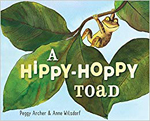 “In the middle of a puddle / in the middle of the road / on a teeter-totter twig / sat a teeny-tiny toad.” A snap of the twig catapults the little toad into an accidental journey that takes him from a “raggy-shaggy” tree to a flower, and then to other places along the roadside. When a “huff-puff wind with a cloud of dust” tosses him onto a child’s sneaker, the hippy-hoppy toad ends up back on the “teeter-totter twig” where this circular story poem with its tongue-tapping verses began. Lively, colorful, watercolor and ink illustrations set the scene and enrich this mini-adventure filled with rhythmic wordplay that children are going to want to read (or have read to them) again and again.
“In the middle of a puddle / in the middle of the road / on a teeter-totter twig / sat a teeny-tiny toad.” A snap of the twig catapults the little toad into an accidental journey that takes him from a “raggy-shaggy” tree to a flower, and then to other places along the roadside. When a “huff-puff wind with a cloud of dust” tosses him onto a child’s sneaker, the hippy-hoppy toad ends up back on the “teeter-totter twig” where this circular story poem with its tongue-tapping verses began. Lively, colorful, watercolor and ink illustrations set the scene and enrich this mini-adventure filled with rhythmic wordplay that children are going to want to read (or have read to them) again and again.
—NB
A House That Once Was. Julie Fogliano. Ill. Lane Smith. 2018. Roaring Brook.
 “Deep in the woods / is a house / just a house / that once was / but now isn’t / a home.” Julie Fogliano’s lyrical text and Lane Smith’s beautifully composed mixed-media artwork tell a thought-provoking story of how two children come upon this derelict house in the woods. They enter through a now paneless window and, while exploring the contents of the house, wonder about the previous occupants whose portraits hang on the walls. Who were they? Where did they go? Is the house waiting for them to return? Or is the house just remembering stories of “someone who we’ll never know.” Going back through the window, the two children return to their cozy and warm home, leaving behind the house deep in the woods.
“Deep in the woods / is a house / just a house / that once was / but now isn’t / a home.” Julie Fogliano’s lyrical text and Lane Smith’s beautifully composed mixed-media artwork tell a thought-provoking story of how two children come upon this derelict house in the woods. They enter through a now paneless window and, while exploring the contents of the house, wonder about the previous occupants whose portraits hang on the walls. Who were they? Where did they go? Is the house waiting for them to return? Or is the house just remembering stories of “someone who we’ll never know.” Going back through the window, the two children return to their cozy and warm home, leaving behind the house deep in the woods.
—CA
Pretty Kitty. Karen Beaumont. Ill. Stephanie Laberis. 2018. Godwin/Henry Holt.
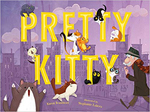 As an old man walks along a city street, he comes upon a stray cat. “Pretty kitty. Wants a pat. / Don’t you look at me like that. / I do not want a kitty cat. / SCAT!” As time passes, more kittens follow him home and, despite his repeated insistence that he does not want a kitty cat, the old man ends up with 10 on his door mat. On a cold and snowy day, he opens his home to the freezing kitties. The colorful, digital illustration in this rhyming, counting book shows the old man snoozing before his fireplace surrounded by kitty cats. “Old man. / Big city. / Loves each, / pretty little kitty.”
As an old man walks along a city street, he comes upon a stray cat. “Pretty kitty. Wants a pat. / Don’t you look at me like that. / I do not want a kitty cat. / SCAT!” As time passes, more kittens follow him home and, despite his repeated insistence that he does not want a kitty cat, the old man ends up with 10 on his door mat. On a cold and snowy day, he opens his home to the freezing kitties. The colorful, digital illustration in this rhyming, counting book shows the old man snoozing before his fireplace surrounded by kitty cats. “Old man. / Big city. / Loves each, / pretty little kitty.”
—CA
Yellow Kayak. Nina Laden. Ill. Melissa Castrillon. 2018. Paula Wiseman/Simon & Schuster.
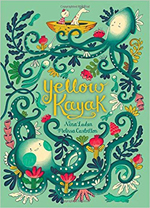 Simple rhymes tell the story of a boy and a giraffe’s adventure launched with “Yellow kayak. / Blue sky. / Paddle swiftly. / Wave good-bye.” The two enjoy their excursion until they are overcome by a dangerous squall. A frightening night on the water is followed by a comforting rescue from an unexpected source. Stylized, surrealistic artwork (created in pencil and digitally colored in a predominately turquoise, rose, and gold palette) complement this lyrical narrative of friendship and perseverance that concludes with the boy and giraffe sitting on a dock next to their kayak. “Orcas dive. / Shunning glory. / Leaving only / this sea story.”
Simple rhymes tell the story of a boy and a giraffe’s adventure launched with “Yellow kayak. / Blue sky. / Paddle swiftly. / Wave good-bye.” The two enjoy their excursion until they are overcome by a dangerous squall. A frightening night on the water is followed by a comforting rescue from an unexpected source. Stylized, surrealistic artwork (created in pencil and digitally colored in a predominately turquoise, rose, and gold palette) complement this lyrical narrative of friendship and perseverance that concludes with the boy and giraffe sitting on a dock next to their kayak. “Orcas dive. / Shunning glory. / Leaving only / this sea story.”
—NB
Ages 9–11
Knockout. K. A. Holt. 2018. Chronicle.
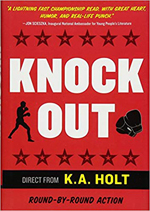 Twelve-year-old Levi just wants to be a regular kid. Born premature at only two pounds, he spent his childhood in and out of hospitals, relying on a trach to survive. Now a middle schooler, his mom and overprotective brother, Timothy, still think of him as damaged while his schoolmates see him as the same class clown he's always been. At his father’s encouragement, Levi learns to box without telling his mom or Timothy, until he suffers a concussion. After his family helps him apply to a boarding school with a boxing program, his confidence returns. “Hey, Xaviers, Levi is in the house, / and you know what? / I am going to / KNOCK YOU OUT.” The inclusion of some concrete poetry enriches this realistic verse novel that delivers a powerful punch. Readers can learn more about Levi and his family in the earlier companion book, House Arrest (2015).
Twelve-year-old Levi just wants to be a regular kid. Born premature at only two pounds, he spent his childhood in and out of hospitals, relying on a trach to survive. Now a middle schooler, his mom and overprotective brother, Timothy, still think of him as damaged while his schoolmates see him as the same class clown he's always been. At his father’s encouragement, Levi learns to box without telling his mom or Timothy, until he suffers a concussion. After his family helps him apply to a boarding school with a boxing program, his confidence returns. “Hey, Xaviers, Levi is in the house, / and you know what? / I am going to / KNOCK YOU OUT.” The inclusion of some concrete poetry enriches this realistic verse novel that delivers a powerful punch. Readers can learn more about Levi and his family in the earlier companion book, House Arrest (2015).
—NB
Rebound. Kwame Alexander. Ill. Dawud Anyabwile. 2018. Houghton Mifflin.
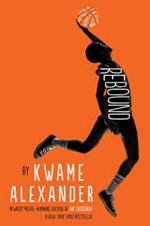 In this companion/prequel to his 2015 Newbery Medal-winning The Crossover, Kwame Alexander tells the story of how Charlie Bell, who is dealing with grief over the death of his father and making poor choices, is sent by his mother to spend the summer with his grandparents in Washington, D.C. “It was the summer of 1988, / when basketball gave me wings // and I had to learn / how to rebound // on the court, / And off.” Not allowed to idle the summer away, Charlie is kept busy doing chores and spending time with Cousin Roxie, the star of the basketball team at the Boys and Girls Club, where Granddaddy Bell volunteers. Some of the free verse poems in Alexander’s coming-of-age novel are in graphic novel panels (with black-and-white artwork by Dwud Anyabwile) in which comic book-loving Charlie is the superhero basketball star he dreams of being.
In this companion/prequel to his 2015 Newbery Medal-winning The Crossover, Kwame Alexander tells the story of how Charlie Bell, who is dealing with grief over the death of his father and making poor choices, is sent by his mother to spend the summer with his grandparents in Washington, D.C. “It was the summer of 1988, / when basketball gave me wings // and I had to learn / how to rebound // on the court, / And off.” Not allowed to idle the summer away, Charlie is kept busy doing chores and spending time with Cousin Roxie, the star of the basketball team at the Boys and Girls Club, where Granddaddy Bell volunteers. Some of the free verse poems in Alexander’s coming-of-age novel are in graphic novel panels (with black-and-white artwork by Dwud Anyabwile) in which comic book-loving Charlie is the superhero basketball star he dreams of being.
—CA
Ages 12–14
Jazz Owls: A Novel of the Zoot Suit Riots. Margarita Engle. Ill. Rudy Gutierrez. 2018. Atheneum/Simon & Schuster.
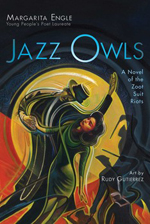 With titled, free-verse poems, Margarita Engle tells the story of a little-known dark episode in U.S. history during World War II. Mexican-American 16-year-old Marisela and 14-year-old Lorena work in a cannery by day and, as Jazz Owls, jitterbug all night at a Los Angeles USO club with sailors shipping out to the front lines. In June 1943, Mexican-American youth, including 12-year-old zoot suit-wearing Ray, are brutally attacked by sailors in a week-long period of racial violence in what became known as the Zoot Suit Riots. Back matter includes an author’s note providing a context for this work of historical fiction and references.
With titled, free-verse poems, Margarita Engle tells the story of a little-known dark episode in U.S. history during World War II. Mexican-American 16-year-old Marisela and 14-year-old Lorena work in a cannery by day and, as Jazz Owls, jitterbug all night at a Los Angeles USO club with sailors shipping out to the front lines. In June 1943, Mexican-American youth, including 12-year-old zoot suit-wearing Ray, are brutally attacked by sailors in a week-long period of racial violence in what became known as the Zoot Suit Riots. Back matter includes an author’s note providing a context for this work of historical fiction and references.
—CA
Siege: How General Washington Kicked the British Out of Boston and Launched a Revolution. Roxane Orgill. 2018. Candlewick.
 It is 1775, and the U.S. colonies are rebelling. George Washington, the first commander in chief, must create a professional army out of an undisciplined militia, comprised mostly of farmers, to force the British out. The story is told through various voices and sources of information (including George Washington, Washington’s aide-de-camp, Martha Washington, a slave, a private, a British commander, Abigail Adams, Washington’s daily General Orders, and the Boston News). In novel-in-verse format, Orgill unfolds how inexperienced Washington freed Boston in March of 1776 from British captivity and isolation, resulting in a turning point in the Revolutionary War. A cast of characters and an introduction begin this historical novel. Back matter includes a map, portraits of characters, a glossary, source notes, and a bibliography.
It is 1775, and the U.S. colonies are rebelling. George Washington, the first commander in chief, must create a professional army out of an undisciplined militia, comprised mostly of farmers, to force the British out. The story is told through various voices and sources of information (including George Washington, Washington’s aide-de-camp, Martha Washington, a slave, a private, a British commander, Abigail Adams, Washington’s daily General Orders, and the Boston News). In novel-in-verse format, Orgill unfolds how inexperienced Washington freed Boston in March of 1776 from British captivity and isolation, resulting in a turning point in the Revolutionary War. A cast of characters and an introduction begin this historical novel. Back matter includes a map, portraits of characters, a glossary, source notes, and a bibliography.
—NB
Ages 15+
Blood Water Paint. Joy McCullough. 2018. Douglas & McIntyre Dutton/Penguin.
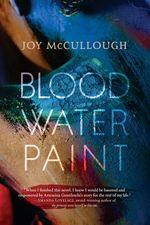 Seventeen-year-old Artemisia Gentileschi is her mediocre painter father’s best kept secret: He sells her art as his own. Before she died, Artemisia’s mother prepared her for Rome’s patriarchal and sexist society through her interpretations of Bible figures Susanna and Judith, who suffered and stood up to their abusers. Artemisia works through her own seduction and violent abuse by mentor Agostino Tassi as she paints the truths of these women: “Judith takes one of my hands, / Susanna takes the other. / They plunge my fingers into paint, / smear them across the outstretched cloth.” This powerful book portrays an original #MeToo story, complete with a trial. The afterword and acknowledgments provide information on McCullough’s retellings of the true story of the famous Italian Baroque painter Artemisia Gentileschi (1593–1656), written first as a play and then this novel in free verse, interspersed with Artemisia’s mother’s stories in prose.
Seventeen-year-old Artemisia Gentileschi is her mediocre painter father’s best kept secret: He sells her art as his own. Before she died, Artemisia’s mother prepared her for Rome’s patriarchal and sexist society through her interpretations of Bible figures Susanna and Judith, who suffered and stood up to their abusers. Artemisia works through her own seduction and violent abuse by mentor Agostino Tassi as she paints the truths of these women: “Judith takes one of my hands, / Susanna takes the other. / They plunge my fingers into paint, / smear them across the outstretched cloth.” This powerful book portrays an original #MeToo story, complete with a trial. The afterword and acknowledgments provide information on McCullough’s retellings of the true story of the famous Italian Baroque painter Artemisia Gentileschi (1593–1656), written first as a play and then this novel in free verse, interspersed with Artemisia’s mother’s stories in prose.
—NB
Moonrise. Sarah Crossan. 2018. Bloomsbury.
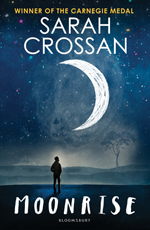 Seventeen-year-old Joe has not seen his older brother, Ed, who is on death row for the murder of a police officer, in 10 years. When the date of his brother’s execution is set, Joe travels across the country to Wakeling, Texas, to make daily visits to Ed, who says he’s innocent and hopes for a stay of execution. Titled poems move back and forth between the past and present, revealing Joe’s close attachment to Ed during a difficult early childhood with a neglectful, abusive mother and his emotional turmoil— anger, confusion, and hopelessness—until Ed runs out of appeals and is executed. “I should be ready for this pain, / but I’m not / because I never believed / that Ed would die.” Crossan’s beautifully crafted verse novel is heart-wrenching. It’s not easy to read, and it’s impossible to stop thinking about.
Seventeen-year-old Joe has not seen his older brother, Ed, who is on death row for the murder of a police officer, in 10 years. When the date of his brother’s execution is set, Joe travels across the country to Wakeling, Texas, to make daily visits to Ed, who says he’s innocent and hopes for a stay of execution. Titled poems move back and forth between the past and present, revealing Joe’s close attachment to Ed during a difficult early childhood with a neglectful, abusive mother and his emotional turmoil— anger, confusion, and hopelessness—until Ed runs out of appeals and is executed. “I should be ready for this pain, / but I’m not / because I never believed / that Ed would die.” Crossan’s beautifully crafted verse novel is heart-wrenching. It’s not easy to read, and it’s impossible to stop thinking about.
—CA
The Poet X. Elizabeth Acevedo. 2018. HarperTeen/HarperCollins.
 Tall, curvy, 15-year-old Dominican-American Xiomara Batista fights unwanted advances from boys and men. However, she is interested in Aman, her science partner, and he becomes her secret boyfriend even though she knows that her strict, religious mother and reformed run-around father wouldn’t tolerate their relationship. Xiomara’s perspective unfolds through her writing notebook in which she questions religion, sexuality, and authority, as well as through prose assignments for her English class. She joins her school’s Spoken World Poetry Club and performs her original slam poetry under the stage name Poet X. “I stand on a stage and / say a poem. /There is power in the word." Xiomara realizes that, through poetry, her family, friends, priest, and everyone will finally hear what she needs to tell them. Acevedo’s poignant and emotional writing, interspersed with Spanish, hits the gut with authenticity and wisdom.
Tall, curvy, 15-year-old Dominican-American Xiomara Batista fights unwanted advances from boys and men. However, she is interested in Aman, her science partner, and he becomes her secret boyfriend even though she knows that her strict, religious mother and reformed run-around father wouldn’t tolerate their relationship. Xiomara’s perspective unfolds through her writing notebook in which she questions religion, sexuality, and authority, as well as through prose assignments for her English class. She joins her school’s Spoken World Poetry Club and performs her original slam poetry under the stage name Poet X. “I stand on a stage and / say a poem. /There is power in the word." Xiomara realizes that, through poetry, her family, friends, priest, and everyone will finally hear what she needs to tell them. Acevedo’s poignant and emotional writing, interspersed with Spanish, hits the gut with authenticity and wisdom.
—NB
Nancy Brashear is Professor Emeritus of English from Azusa Pacific University, in Azusa, California. Carolyn Angus is former director of the George G. Stone Center for Children's Books, Claremont Graduate University, in Claremont, California.
These reviews are submitted by members of the International Literacy Association's Children's Literature and Reading Special Interest Group (CL/R SIG) and are published weekly on Literacy Daily.